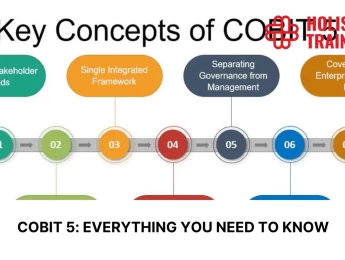- Table of Contents
- Introduction
- What Is COBIT 5?
- The 5 Principles of COBIT
- 1. Meeting Stakeholder Needs
- 2. Covering the Enterprise End-to-End
- 3. Applying a Single Integrated Framework
- 4. Enabling a Holistic Approach
- 5. Separating Governance From Management
- The History of COBIT 5
- How Is COBIT 5 Related to ISACA?
- Benefits of COBIT 5
- Improved Risk Management
- Enhanced Business Alignment
- Increased Operational Efficiency
- Regulatory Compliance
- Enhanced Strategic Decision-Making
- Improved Stakeholder Confidence
- Continuous Improvement Culture
- Using an Integrated Approach with Other Frameworks
- ITIL Integration
- ISO 20000 Integration
- ISO 27001 Integration
- Unlocking Synergy for Holistic Governance
- What Should You Know Before Using COBIT?
- 1. Executive Support
- 2. Comprehensive Training
- 3. Tailoring the Framework
- 4. Holistic Organisational Integration
- 5. Communication and Change Management
- How to Start Integrating COBIT in Your Organisation
- 1. Conduct a Governance Assessment
- 2. Define Governance Objectives
- 3. Develop a Roadmap
- 4. Build Awareness and Training Programs
- 5. Monitor and Continuously Improve
- 6. Executive Leadership and Support
- 7. Foster Collaboration Across Departments
- 8. Establish Key Performance Indicators (KPIs)
- 9. Address Change Management
- 10. Embrace Continuous Learning
- Final Word
Introduction
Navigating the complex landscape of IT governance requires a strategic and structured approach, and COBIT 5 stands as a beacon in this endeavour. In this comprehensive guide, we'll delve into the intricacies of COBIT 5, exploring its principles, historical roots, relationship with ISACA, benefits, and practical integration with ITIL®, ISO 20000, and ISO 27001. If you're aiming to enhance your organisation's governance framework, understanding COBIT 5 is the first step towards achieving that goal.
What Is COBIT 5?
At its core, COBIT 5, short for Control Objectives for Information and Related Technologies, is a globally recognised framework designed to help organisations govern and manage their information and technology. It provides a holistic approach, aligning business goals with IT processes and ensuring that organisations can extract maximum value from their technology investments.
The 5 Principles of COBIT
1. Meeting Stakeholder Needs
COBIT 5's emphasis on meeting stakeholder needs extends beyond mere satisfaction—it strives for a proactive understanding of expectations. By engaging stakeholders at every level, from executives to end-users, organisations can create a governance framework that anticipates evolving requirements. This principle prompts the establishment of feedback mechanisms, ensuring that the dynamic nature of stakeholder needs remains at the forefront of decision-making processes.
2. Covering the Enterprise End-to-End
In the intricate web of modern enterprises, COBIT 5 recognises the interconnectedness of processes and functions. This principle encourages organisations to look beyond individual departments and silos, fostering collaboration and communication across the entire enterprise. By adopting an end-to-end approach, organisations gain a panoramic view of their IT landscape, allowing for more informed decision-making and holistic risk management.
3. Applying a Single Integrated Framework
The integration of various frameworks and standards underlines the adaptability and scalability of COBIT 5. This principle encourages organisations to leverage existing structures such as ITIL and ISO standards, creating a unified and efficient governance environment. By weaving a tapestry of best practices into a single integrated framework, organisations can avoid redundancy, reduce complexity, and enhance the overall effectiveness of their governance processes.
4. Enabling a Holistic Approach
COBIT 5's call for a holistic approach extends beyond the technical realm—it permeates the cultural fabric of an organisation. By embracing a holistic mindset, organisations recognise the symbiotic relationship between people, processes, and technology. This principle encourages a shift from reactive problem-solving to proactive governance, fostering a culture where all components work in concert to achieve strategic objectives.
5. Separating Governance From Management
The clear demarcation between governance and management in COBIT 5 is foundational to establishing accountability and transparency. This principle emphasises that governance is the responsibility of the board and executive leadership, focusing on strategic alignment and risk management. Management, on the other hand, is responsible for executing these strategies and ensuring day-to-day operations run smoothly. This separation ensures a well-defined structure, preventing conflicts of interest and promoting a balanced and effective governance environment.
The History of COBIT 5
The history of COBIT dates back to the late 1990s when the Information Systems Audit and Control Association (ISACA) recognised the need for a framework that could bridge the gap between business and IT. Over the years, COBIT evolved, incorporating industry best practices and adapting to the changing technological landscape. Today, COBIT 5 stands as the latest iteration, a testament to its continuous improvement and relevance in the dynamic world of IT governance.
How Is COBIT 5 Related to ISACA?
ISACA, a global professional association for IT governance, plays a pivotal role in the development and promotion of COBIT. COBIT is not just a framework; it's a product of collaboration and expertise from ISACA's members worldwide. ISACA's involvement ensures that COBIT remains aligned with industry standards and adapts to emerging challenges, making it a trustworthy resource for organisations seeking effective governance solutions.
Benefits of COBIT 5
Implementing COBIT 5 yields a multitude of benefits for organisations:
Improved Risk Management
COBIT 5 provides organisations with a structured and proactive approach to risk management. By integrating risk considerations into the fabric of governance processes, organisations can identify potential threats early on, assess their impact, and implement mitigation strategies. This not only safeguards the organisation's assets but also enhances its overall resilience in the face of uncertainties.
Enhanced Business Alignment
The stakeholder-centric approach of COBIT 5 ensures that IT goals are not isolated but intricately woven into the broader fabric of business objectives. This alignment is more than a checkbox exercise; it's a strategic integration that ensures IT investments directly contribute to the organisation's mission and vision. By harmonising business and IT, COBIT 5 enables organisations to derive maximum value from their technological investments.
Increased Operational Efficiency
COBIT 5's integrated and holistic nature brings about operational efficiency by eliminating redundancies and optimising processes. Reducing operational complexities results in a leaner IT environment, driving down costs and enhancing overall performance. This efficiency extends beyond cost savings—it positively impacts service delivery, agility, and the organisation's ability to adapt to evolving market demands.
Regulatory Compliance
Adhering to a myriad of regulatory requirements is an ongoing challenge for organisations. COBIT 5 serves as a valuable ally in navigating this complex landscape. By providing a structured framework for compliance, organisations can ensure that their governance practices align with legal and regulatory standards. This not only mitigates legal risks but also fosters a culture of ethical and responsible IT management.
Enhanced Strategic Decision-Making
COBIT 5 facilitates informed and strategic decision-making at all levels of the organisation. By providing a comprehensive view of IT processes and their alignment with business objectives, COBIT enables executives to make decisions that have a profound impact on the organisation's future. This strategic foresight extends to resource allocation, technology investments, and overall business planning.
Improved Stakeholder Confidence
A robust governance framework instils confidence among stakeholders. Whether it's customers, shareholders, or regulatory bodies, the transparent and accountable nature of COBIT 5 reassures stakeholders that the organisation is committed to sound IT governance practices. This enhanced confidence can lead to improved relationships, increased trust, and a positive reputation in the market.
Continuous Improvement Culture
COBIT 5 fosters a culture of continuous improvement. By regularly assessing and reassessing governance processes, organisations can identify areas for enhancement and adaptation. This commitment to ongoing improvement ensures that the governance framework remains dynamic, responsive, and aligned with the organisation's evolving needs and challenges.
In short, the benefits of COBIT 5 extend far beyond the realms of IT governance. By weaving together risk management, business alignment, operational efficiency, regulatory compliance, strategic decision-making, stakeholder confidence, and a culture of continuous improvement, COBIT 5 serves as a catalyst for organisational excellence in the rapidly evolving landscape of information and technology governance. Embracing COBIT 5 is not just an investment in governance; it's an investment in the sustained success and resilience of the entire organisation.
Using an Integrated Approach with Other Frameworks
COBIT 5 doesn't exist in isolation; it thrives when integrated with other frameworks and standards. Combining COBIT with ITIL, ISO 20000, and ISO 27001 creates a powerful synergy, addressing various aspects of IT service management, quality, and information security.
ITIL Integration
Integrating COBIT with ITIL (Information Technology Infrastructure Library) is a strategic move for organisations seeking to optimise their IT service management. While COBIT provides a comprehensive governance framework, ITIL focuses on the best practices for IT service delivery and support. By aligning the two, organisations can bridge the gap between governance and operational processes, ensuring that IT services not only meet business objectives but also adhere to international standards of service management.
The alignment with ITIL enhances service delivery, incident management, and problem resolution processes. It streamlines operations, reduces service disruptions, and promotes a customer-centric approach. The combined power of COBIT andITIL allows organisations to strike a delicate balance between governance and operational efficiency, resulting in a more agile and responsive IT environment.
ISO 20000 Integration
ISO 20000, an international standard for IT service management, dovetails seamlessly with COBIT 5. While COBIT provides a governance framework, ISO 20000 offers a set of globally recognised practices for delivering high-quality IT services. Integrating these two standards ensures that organisations not only govern their IT processes effectively but also deliver services in line with international best practices.
By combining COBIT and ISO 20000, organisations create a comprehensive service management system that adheres to quality standards. This integration facilitates the establishment of service level agreements (SLAs), continual service improvement, and effective communication with stakeholders. The result is a well-orchestrated IT service management approach that aligns with organisational objectives and industry benchmarks.
ISO 27001 Integration
Information security is a paramount concern in today's digital landscape, and the integration of COBIT 5 withISO 27001 addresses this critical aspect. While COBIT provides a holistic governance framework, ISO 27001 focuses specifically on information security management. Integrating these frameworks ensures that organisations not only govern their IT processes but also safeguard their sensitive information in accordance with international standards.
The synergy between COBIT and ISO 27001 strengthens an organisation's information security posture. It ensures the identification and management of information security risks, compliance with regulatory requirements, and the establishment of a robust information security management system. This integration is particularly vital in an era where data breaches and cyber threats pose significant challenges to organisations across industries.
Unlocking Synergy for Holistic Governance
The integration of COBIT 5 with ITIL, ISO 20000, and ISO 27001 is not merely a technical alignment; it represents a strategic move towards holistic governance. This integrated approach allows organisations to leverage the strengths of each framework, creating a synergy that transcends individual components.
By aligning with ITIL, organisations ensure that their IT service management practices are not just efficient but also aligned with business goals. ISO 20000 integration elevates service quality, providing a foundation for continual improvement. Simultaneously, integrating with ISO 27001 fortifies the organisation's defences against evolving cyber threats, safeguarding its most valuable asset—information.
This integrated approach isn't about creating silos of governance; it's about breaking down barriers and fostering collaboration. It encourages a culture where governance, service management, and information security are viewed as interdependent elements of a larger, cohesive whole. Organisations that master this integrated approach benefit from a governance ecosystem that is not only robust and secure but also responsive to the dynamic challenges of the digital era.
In summary, the integration of COBIT 5 with ITIL, ISO 20000, and ISO 27001 represents a strategic convergence of governance, service management, and information security. This synergy empowers organisations to navigate the complexities of the modern IT landscape with confidence, resilience, and a commitment to delivering value to stakeholders. Embrace the integrated approach, and unlock the full potential of a governance ecosystem that transcends individual frameworks for the holistic betterment of your organisation.
What Should You Know Before Using COBIT?
Before embarking on the journey of integrating COBIT 5 into your organisation, certain key considerations should be kept in mind:
1. Executive Support
Securing executive support is not just a checkbox; it's the cornerstone of successful COBIT implementation. Leadership commitment goes beyond mere endorsement—it's about fostering a culture of governance from the top down. Executives should actively champion the integration of COBIT, emphasising its strategic importance and impact on organisational success. The commitment of leadership sets the tone for the entire organisation, creating a governance mindset that permeates all levels.
2. Comprehensive Training
Comprehensive training is not just about familiarity with COBIT's concepts; it's about instilling a deep understanding of its principles and practical applications. Training programs should go beyond theoretical knowledge, providing real-world scenarios and hands-on experiences. By ensuring that personnel possess the skills to effectively apply COBIT in their specific roles, organisations empower their workforce to become active contributors to the governance culture.
3. Tailoring the Framework
While COBIT provides a robust foundation, organisations must recognise that one size does not fit all. Tailoring the framework to the specific needs of the organisation is a nuanced process. It involves a detailed analysis of industry requirements, organisational structure, and unique challenges. This customisation ensures that COBIT becomes more than a framework; it becomes a tailored solution that resonates with the organisation's DNA, aligning seamlessly with its goals and values.
4. Holistic Organisational Integration
COBIT is not just a set of guidelines for the IT department—it's a holistic governance framework that encompasses the entire organisation. Before implementation, organisations should evaluate how COBIT integrates with existing processes, structures, and cultures. It's about weaving COBIT into the fabric of the organisation, ensuring that it becomes an integral part of decision-making processes, risk management, and daily operations.
5. Communication and Change Management
Implementing COBIT requires effective communication and change management strategies. The introduction of a governance framework may trigger resistance or confusion among employees. Communicating the benefits, objectives, and expected outcomes of COBIT is crucial for garnering support. Simultaneously, organisations need to implement change management strategies that address cultural shifts, ensuring a smooth transition to the new governance paradigm.
Before venturing into the realm of COBIT, organisations should view it not just as a project but as a transformative journey. It's a journey that requires commitment, understanding, and a collaborative effort from all facets of the organisation. By acknowledging these considerations, organisations set the stage for a successful integration of COBIT, laying the groundwork for effective governance that extends beyond compliance to become a driving force for organisational excellence.
How to Start Integrating COBIT in Your Organisation
Embarking on the journey of integrating COBIT 5 requires a systematic approach:
Embarking on the journey of integrating COBIT 5 into your organisation requires a systematic and strategic approach. The successful integration of COBIT is not a one-time task; it's an ongoing process that requires commitment, collaboration, and adaptability. Here's a comprehensive guide on how to start this transformative journey:
1. Conduct a Governance Assessment
Before diving into COBIT implementation, conduct a thorough assessment of your organisation's current governance landscape. Identify existing governance structures, processes, and areas that require improvement. This assessment serves as a baseline, allowing you to tailor COBIT to address specific needs and challenges within your organisation.
2. Define Governance Objectives
Clearly articulate governance objectives that align with your organisation's strategic goals. These objectives serve as the guiding principles for the integration of COBIT. Whether it's improving risk management, enhancing stakeholder satisfaction, or ensuring regulatory compliance, clearly defined objectives provide a roadmap for the implementation process.
3. Develop a Roadmap
Create a detailed roadmap for the implementation of COBIT. Define key milestones, allocate necessary resources, and establish realistic timelines. A well-structured plan not only ensures a smooth transition but also facilitates effective monitoring and adjustment as the implementation progresses. This roadmap should be flexible enough to accommodate unexpected challenges and changes in organisational priorities.
4. Build Awareness and Training Programs
Communication is vital when introducing a new governance framework. Build awareness among employees about the benefits and objectives of COBIT. Establish training programs to equip relevant personnel with the knowledge and skills required for successful COBIT implementation. An informed and trained workforce becomes a driving force in the integration process, fostering a culture of governance throughout the organisation.
5. Monitor and Continuously Improve
Governance is an ongoing process, and COBIT integration is no exception. Implement monitoring mechanisms to track the effectiveness of COBIT in real-time. Regularly assess performance against defined objectives, gather feedback from stakeholders, and make continuous improvements to the framework. This iterative approach ensures that COBIT remains dynamic and responsive to the evolving needs of the organisation.
6. Executive Leadership and Support
Secure executive leadership and support is crucial for the success of COBIT integration. Executives should not only endorse the initiative but actively champion it. Leadership commitment sets the tone for the entire organisation, creating a governance culture that permeates from the top down. Engage executives in the process, ensuring they understand the strategic importance of COBIT in achieving organisational goals.
7. Foster Collaboration Across Departments
COBIT is not confined to the IT department; it spans the entire organisation. Foster collaboration across departments to ensure a holistic integration. Involve key stakeholders from various business units to gather diverse perspectives and insights. This collaborative approach ensures that COBIT aligns with the unique needs and objectives of each department, fostering a cohesive and integrated governance environment.
8. Establish Key Performance Indicators (KPIs)
Define Key Performance Indicators (KPIs) to measure the success of COBIT integration. These KPIs should align with the governance objectives and provide tangible metrics for evaluating the impact of COBIT on organisational performance. Regularly assess these KPIs and use the insights gained to make informed decisions and adjustments to the implementation strategy. Here are some examples:
KPI | Description | Measurement Criteria |
Stakeholder Satisfaction | Assess satisfaction with IT governance. | Regular surveys, feedback, and communication. |
Risk Management Effectiveness | Evaluate the success of risk management. | Number of identified risks vs. mitigated risks. |
Operational Efficiency | Measure efficiency gains in IT operations. | Reduction in redundancies and optimised processes. |
Regulatory Compliance | Ensure adherence to relevant regulations. | Number of compliance violations and corrective actions. |
Strategic Decision-Making | Evaluate the impact on strategic decision-making. | Alignment of IT strategies with organisational goals. |
Table 1: KPIs to Measure the Success of COBIT Integration
9. Address Change Management
Implement effective change management strategies to ease the transition to a COBIT-driven governance model. Communicate changes transparently, emphasising the benefits and positive outcomes of COBIT. Address concerns and resistance proactively, fostering a culture where employees embrace the new governance paradigm as a positive and necessary evolution.
10. Embrace Continuous Learning
COBIT is a dynamic framework that evolves to meet the challenges of the digital landscape. Encourage a culture of continuous learning within your organisation. Stay informed about updates and enhancements to the COBIT framework. Regularly train employees to keep their knowledge up-to-date and ensure that your governance practices remain aligned with industry best practices.
In summary, integrating COBIT into your organisation is a strategic journey that requires careful planning, commitment, and collaboration. By following these steps and embracing the principles of COBIT, your organisation can establish a governance framework that not only meets current needs but also adapts to the ever-changing landscape of information and technology governance. The journey towards effective governance begins with a thoughtful and deliberate integration of COBIT into the fabric of your organisation.
Final Word
In conclusion, COBIT 5 stands as a comprehensive and adaptable framework, providing organisations with the tools to navigate the complex landscape of IT governance. By understanding its principles, historical context, and integration possibilities with other frameworks, organisations can unlock the full potential of COBIT, fostering a culture of effective governance and strategic alignment between business and technology. Embrace the journey of integrating COBIT 5, and witness the transformation of your organisation's governance landscape.
In your pursuit of mastering COBIT 5 and elevating your organisation's governance practices, consider enrolling in our exclusive course, "Cybersecurity and Auditing - All You Need to Know." Delve deeper into the intricate realms of IT governance, cybersecurity, and auditing, equipping yourself with invaluable insights and practical skills. Our expert-led course goes beyond theory, providing hands-on experiences and real-world scenarios to enhance your understanding. Seize this opportunity to not only comprehend the nuances of COBIT 5 but also empower yourself with the knowledge essential for navigating the dynamic landscapes of cybersecurity and auditing. Elevate your skills, enhance your career prospects, and lead your organisation towards a secure and resilient future. Enrol now for a transformative learning experience!
























